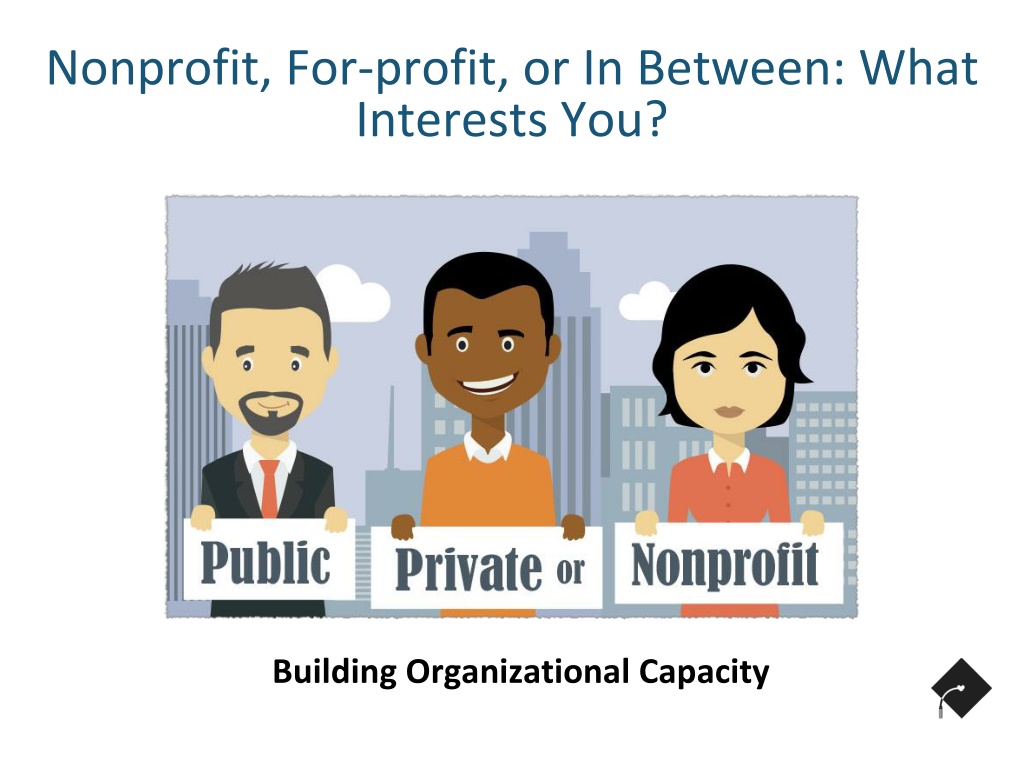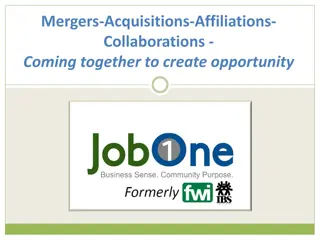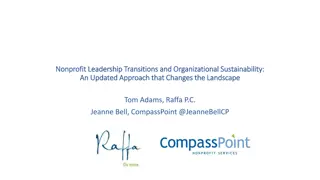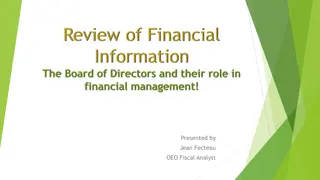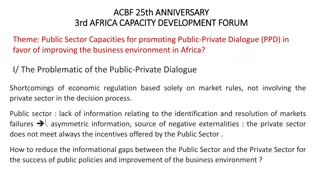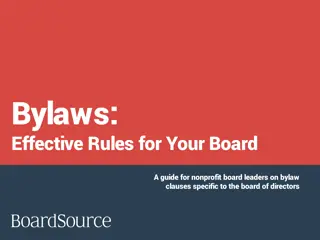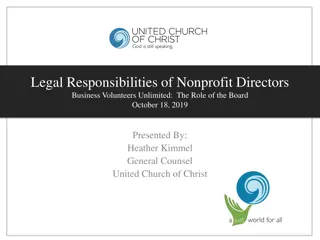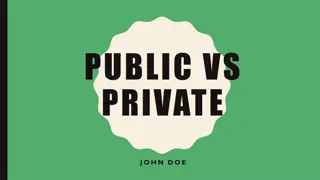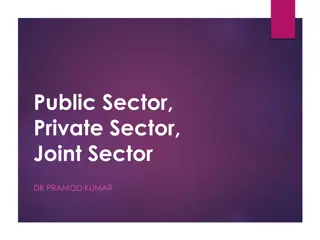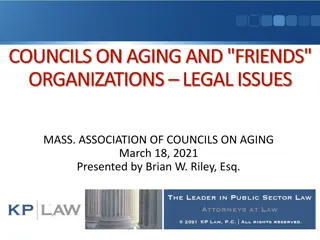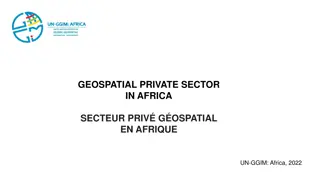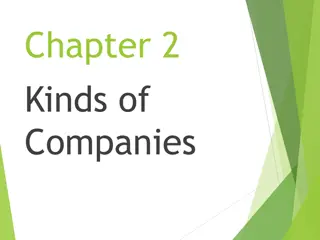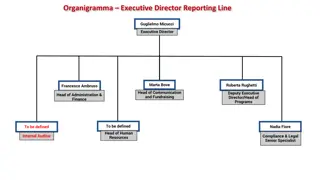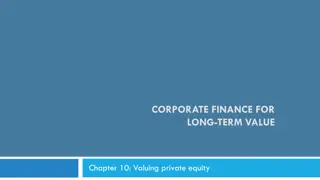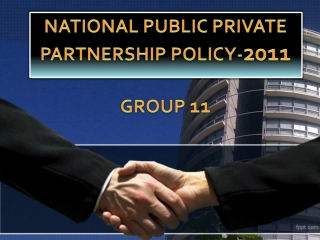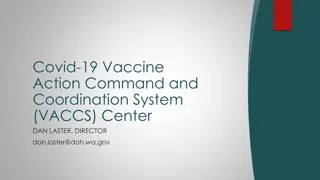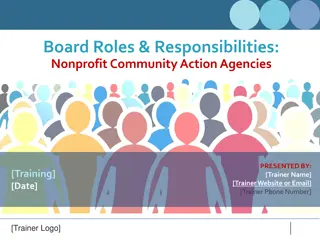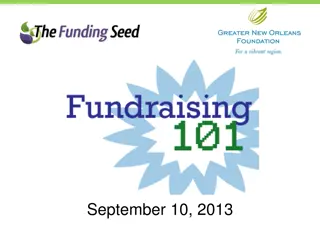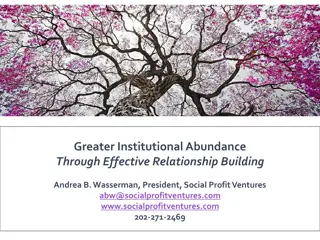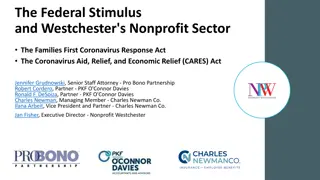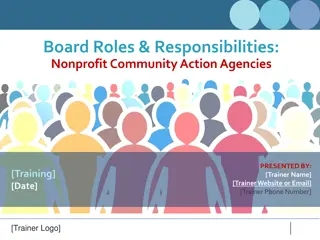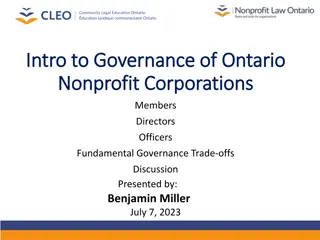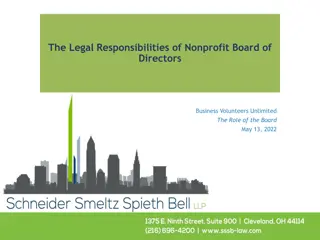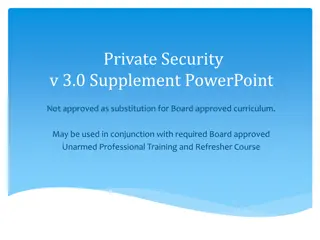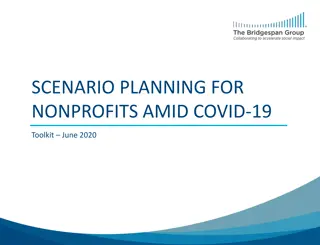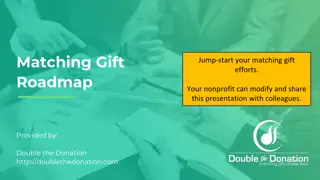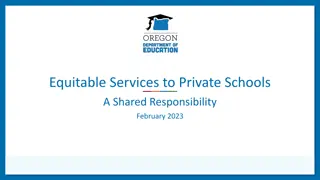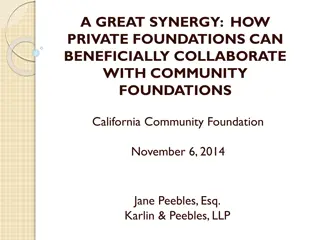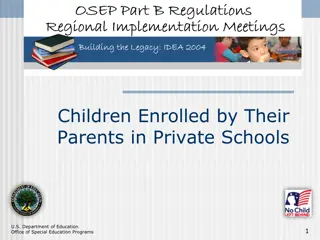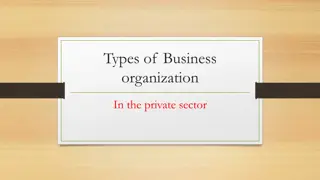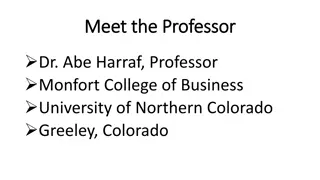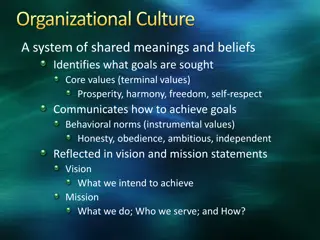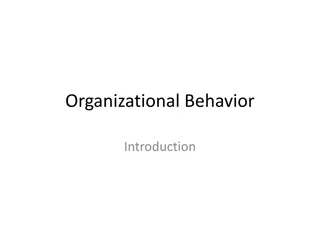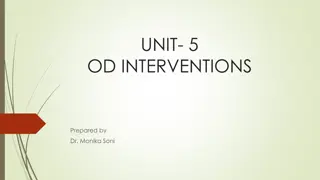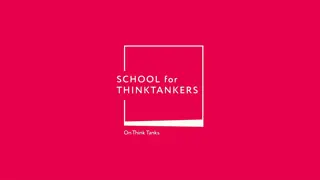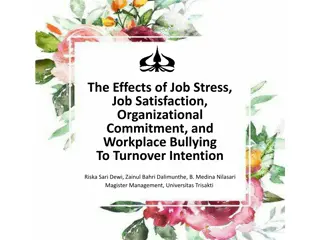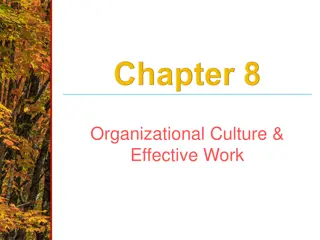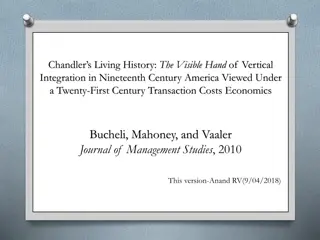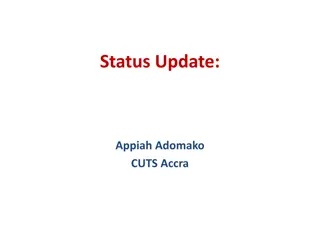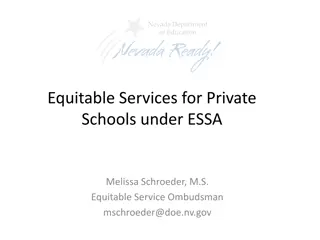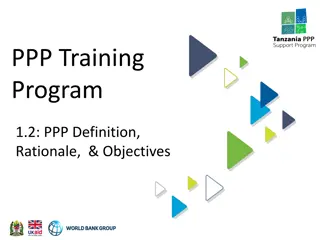Understanding Organizational Sectors: Public, Private, and Nonprofit
Explore the diverse sectors of public, private, and nonprofit organizations, their goals and operations, along with the opportunities they offer for engagement and employment. Gain insights into the significance of building organizational capacity and contributing to societal welfare through various sectors.
Download Presentation

Please find below an Image/Link to download the presentation.
The content on the website is provided AS IS for your information and personal use only. It may not be sold, licensed, or shared on other websites without obtaining consent from the author. Download presentation by click this link. If you encounter any issues during the download, it is possible that the publisher has removed the file from their server.
E N D
Presentation Transcript
Nonprofit, For-profit, or In Between: What Interests You? Building Organizational Capacity
Sector Bingo! Knows someone (e.g. a neighbor) that works in a governmental organization Worked in a for- profit company (e.g. store, bank, restaurant ) Is interested in working with an international nonprofit Is interested in building a nonprofit s social media presence Will share their volunteering / service experience Has raised money for a cause Has bought a product from a socially responsible company Wants to contribute to an organization s work through research Can name two nonprofits in the area
Agenda Introduction to theSectors: Public, Private, Nonprofit Alumni Profiles Reflection and Group Discussion Group Processing and Wrap Up
Sectors Overview Public Nonprofit Private Goal: service, sharing resources, capacity- building Goal: service, welfare, sustainability Goal: expansion, profit Public charities, private foundations; social welfare organizations Local, state, federal government Companies owned by individuals Examples: local government, educational institutions, USPS, military Examples: American Red Cross, Habitat for Humanity Examples: Amazon, Google, UPS The Fourth Sector: Partnerships / Convergence Corporate social responsibility (Pfizer, Tom s) Public parks * private maintenance International Rescue Committee * government Social enterprise (Goodwill industries)
Public Sector Purpose: Implementing public policy, providing government services, ensuring planet sustainability Defined as part of economy Operated by government Run by individuals in Local, State, Federal Agencies Opportunities at all levels local, county, state, federal
22 million people employed in local and state government; 2.8 million employed in the federal government (i.e., 15.9% of the total civilian labor force) Source: the U.S. Bureau of Labor Statistics, September 2021
Why Work in Public Sector? USC Price School of Public Policy, 2018 These jobs and offices affect billions of people everyday and shape the fabric of society
Nonprofit Sector Purpose: Providing services and programs around a particular social mission, intended to benefit people and communities. Voluntary/independent/charitable/com munity or 3rd sector Not under direct government control, not for profit 501(c)3 = exempt from federal income taxes E.g. Community Soup Kitchen, Habitat for Humanity 501(c)4 = nonprofit that also carries out lobbying or policy work E.g. The American Civil Liberties Union, RESULTS Source: USC Price School of Public Policy, 2018
The U.S. nonprofit sector employed third largest workforce of any U.S. industry, behind only retail trade and accommodation and food service, with 12.5 million paid workers. Source: JHCCSS 2020 Nonprofit Employment Report
Why Work in Nonprofit Sector? There are more than 1.6 million nonprofit organizations in the U.S. This includes public charities, private foundations, chambers of commerce, fraternal organizations and civic leagues, etc. National Center for Charitable Statistics (NCCS), 2018
Nonprofit Facts & Figures Independent Sector, 2018
Gen Z and Giving Trends nonprofitpro.Com, 2020
Gen Z and Giving Trends Classy Blog, 2017
Private Sector Purpose: Developing and providing efficient services or goods, making and increasing profit Part of an economy that is not under direct government control Run by individuals and companies for profit Are required to pay taxes (but may be able to get breaks) Also may have a board of directors or chairs
Why Work in Private Sector? The sector offers opportunities at every level and in all kinds of localities. Increasingly, private sector companies are considering their social responsibility and environmental impacts in their business goals.
Social Entrepreneurship The process of launching new businesses to develop, fund and implement solutions to social, cultural, or environmental issues. What is Social Enterprise?
Organizations Supporting Social Entrepreneurs
Organizations Supporting Social Entrepreneurs
Examples of Convergence The Fourth Sector Corporate Foundations where companies devote profits to social good programs Public-Private Partnerships may involve organizations in all 3 sectors Social Enterprise Social Responsibility where nonprofits develop a business aspect or earned income stream where companies (or large nonprofits) track their impacts on places or issues
Sectors Overview Public Nonprofit Private Goal: service, sharing resources, capacity- building Goal: service, welfare, sustainability Goal: expansion, profit Public charities, private foundations; social welfare organizations Local, state, federal government Companies owned by individuals Examples: local government, educational institutions, USPS, military Examples: American Red Cross, Habitat for Humanity Examples: Amazon, Google, UPS The Fourth Sector: Partnerships / Convergence Corporate social responsibility (Pfizer, Tom s) Public parks * private maintenance International Rescue Committee * government Social enterprise (Goodwill industries)
Your Backgrounds & Skills Apply Anywhere Academic Learning: Education, Liberal Arts, Communication, Psychology, Humanities Business, Computer Science, Technology, Electronics Skills: Hard Skills: Writing, Analysis, Marketing, Communication, Financial Management Soft Skills: Managing Teams, Working with Diverse Constituents, Adaptability, Self-motivation, Passion, Long-term commitment Source: https://topnonprofits.com/nonprofit-hiring-the-right-degree/ Source: https://idealistcareers.org/top-nonprofits-look-job-applicants/ Source: https://www.aacu.org/sites/default/files/files/LEAP/2013_EmployerSurvey.pdf
Employers Want Grads Who Can Learn on the Job Hart Associates for AAC&U, 2013
Alumni Profiles J.C. Albittron Kelly Behrend Young Alumni Giving Officer Milton Academy Sustainability and Social Impact Strategist and Founder of Awaken Your Chakras Maria De La Cruz Human Service Administrative Manager Houston Department of Health and Human Services Taylor Duguay Impact and Marketing Strategist United Way of Volusia-Flagler Counties Courtney Edgcomb Director of Community Impact, United Way of Volusia-Flagler Counties Jessica Holcomb Assistant Property Manager Spartanburg Housing Authority Mwenda Alberta Kazadi Jr. Independent Consultant on International Development Shannon Maynard Executive Director of the Congressional Hunger Center Matt Morton Jos Oliva Researcher for Voices of Youth Count (National Homelessness Study) Program Officer/Fellow Z. Smith Reynolds Foundation Stopwatch
Check Out All Alumni Profiles! Visit www.bonner.org
Each one has a Job Profile too Current Position and Journey What makes your job meaningful? Average work day and year? Best and worst thing about job? What you wish you knew?
Discussion What type of work is the alum doing? What sector does it represent? Share one way that the alum s profile deepened your understanding of the sector. How did their academic studies, personal values, and Bonner experiences play a role in this journey? Stopwatch
Questions What careers do you plan to explore? At what kinds of organizations would you like to intern?
Where to Learn More Image This nonprofit, nonpartisan organization strives for a more effective government for the American people. You can find research, places to work, and more. Image This website will help you find jobs and offices on the local and state level especially. Image This website allows you to learn about public policies, legislation, and related efforts.
Where to Learn More With more than 120,000 organizations and 1.4 million monthly visitors to our English and Spanish (idealistas.org) sites, Idealist allows users to search for jobs, internships, organizations, and even resources from nonprofit and non- governmental organizations (NGOs) in countries around the world. Indeed is a for-profit company offering a job site where you can search for jobs, post resumes, and research companies. One of the features of the website is the ability to look up salary information (averages) for particular positions in specific locations. ASPPH is a membership association for graduate schools in public health. It helps people interested in graduate school in the field find and apply to schools. As a Bonner Foundation's national partner, students can get financial discounts on their common application. Also try to find key books, organizations, associations and graduate programs in areas of interest!
Job Sector Guides http://bonner.pbworks.com/ Overview and Careers in the Sector Average Salaries Preparation Required Connection to Bonner Values Considerations Recommendations from Alumni Bonner Alumni in This Field Literature Journals Professional Associations and Organizations
Bonner Resources The Bonner Website http://www.bonner.org The Bonner Wiki http://bonner.pbworks.com/ Bonners on LinkedIn Good luck with your work to learn about finding a place and meaningful work in whatever sectors you choose!
Resources Source: https://www.aacu.org/sites/default/files/files/LEAP/2013_EmployerSurvey.pdf Source: https://www.congress.gov Source: https://www.governmentjobs.com Source: https://idealistcareers.org/top-nonprofits-look-job-applicants/ Source: https://ourpublicservice.org Source: https://ppp.worldbank.org/public-private-partnership/sector Source: https://topnonprofits.com/nonprofit-hiring-the-right-degree/
Credits Book Photo. Banker to the Poor: Micro-Lending and the Battle Against World Poverty. Retrieved from: https://www.amazon.com/Banker-Poor-Micro-Lending-Against-Poverty/dp/1586481983 Bonner Alumni Profiles (2018). Retrieved from www.bonner.org Hart Associates for AAC&U (2013). It Takes More than a Major: Employer Priorities for College Learning and Student Success: Overview and Key Findings. Retrieved from: https://www.aacu.org/leap/presidentstrust/compact/2013SurveySummary National Center for Charitable Statistics (2018). Retrieved from: https://nccs.urban.org Opprann, K (Photographer). (2006, 10th December). Nobel laureate Muhammad Yunus at the Nobel Peace Prize Award Ceremony at Oslo City Hall, The Norwegian Institute. Retrieved from: https://www.nobelprize.org/prizes/peace/2006/yunus/photo-gallery/ Salamon, L. M. & Newhouse, C. (2018). New Report: Nonprofits - America's Third Largest Workforce. Retrieved from: https://trust.guidestar.org/new-report-nonprofits-americas-third-largest-workforce USC Price School of Public Policy (2018). Retrieved from: https://priceschool.usc.edu
